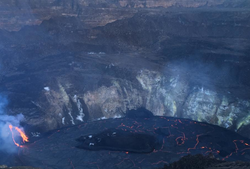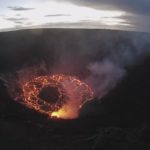Hawaiian Volcano Observatory’s update on the Kilauea eruption as of Sunday morning at 8:53 a.m.:
KILAUEA VOLCANO (VNUM #332010)
19°25’16” N 155°17’13” W, Summit Elevation 4091 ft (1247 m)
Current Volcano Alert Level: WATCH
Current Aviation Color Code: ORANGE
Activity Summary: Lava activity is confined to Halemaʻumaʻu with lava erupting from a vent on the northwest side of the crater. As of 7 am this morning (Dec. 27), the lava lake was 177 m (581 ft) deep with a narrow black ledge around it. Reduced SO2 emissions were measured last night. [Ed. note: The lava lake depth on Saturday was 577 feet, so it only increased 4 feet between yesterday and today.]
Summit Observations: Preliminary analysis of sulfur dioxide emission rates measured yesterday afternoon (Dec. 26) show that the rates have dropped to about 5,000 tonnes/day from about 40,000 t/d (Dec. 21-23) and about 20,000 t/d (Dec. 25). Summit tiltmeters continued to record weak inflationary tilt. Seismicity remained elevated but stable, with steady elevated tremor and a few minor earthquakes.
East Rift Zone Observations: Geodetic monitors also indicate that the upper portion of the East Rift Zone contracted while the summit deflated. This was associated with magma withdrawal to feed the summit vents. There is no seismic or deformation data to indicate that magma is moving into either of Kīlauea’s rift zones.
Halemaʻumaʻu lava lake Observations: The west vent continued erupting lava into a lava lake within Halemaʻumaʻu crater with two narrow channels visible and slightly reduced vigor this morning.
The lava lake within Halemaʻumaʻu crater has changed little in the past day and was about 177 m (581 ft) deep and about 408 m (1,340 ft) below the south Halemaʻumaʻu rim as of this morning (Dec. 27). The lake volume remained about 21 million cubic meters (27 million cubic yards or 4.8 billion gallons). The most recent thermal map provided the lake dimensions as 790 by 520 m (864 by 569 yds) for a total area of 29 ha (72 acres). The narrow (10-30 m or 11-22 yd) ledge around the lake was about 1-2 m (1-2 yds) above the active lake surface suggesting that the lake surface dropped over the past 2 days (https://www.usgs.gov/media/images/december-26-2020-k-lauea-summit-eruption-thermal-map)
Over the past day, the island of cooler, solidified lava floating in the lava lake drifted slowly westward in the lake and remained stable in size–about 260 m (850 ft) in length and 115 m (375 ft) in width based on the Dec. 23rd thermal map (https://www.usgs.gov/maps/december-23-2020-k-lauea-summit-eruption-thermal-map). Measurements this morning suggest that the island rose 1-2 m (3-7 ft) since yesterday afternoon.
Webcam views of the lava lake can be found here: https://volcanoes.usgs.gov/volcanoes/kilauea/multimedia_webcams.html.
Hazard Analysis: High levels of volcanic gas, rockfalls, explosions, and volcanic glass particles are the primary hazards of concern regarding this new activity at Kīlauea’s summit. Large amounts of volcanic gas—primarily water vapor (H2O), carbon dioxide (CO2), and sulfur dioxide (SO2)—are continuously released during eruptions of Kīlauea Volcano. As SO2 is released from the summit during this new eruption, it will react in the atmosphere with oxygen, sunlight, moisture, and other gases and particles, and within hours to days, convert to fine particles. The particles scatter sunlight and cause the visible haze that has been observed downwind of Kīlauea, known as vog (volcanic smog), during previous summit eruptions. Vog creates the potential for airborne health hazards to residents and visitors, damages agricultural crops and other plants, and affects livestock operations. Rockfalls and minor explosions, such as the ones that occurred during the 2008–2018 lava lake eruption at Kīlauea summit, may occur suddenly and without warning. This underscores the extremely hazardous nature of Kīlauea caldera rim surrounding Halemaʻumaʻu crater, an area that has been closed to the public since late 2007. Pele’s hair and other lightweight volcanic glass fragments from the lava fountains within Halemaʻumaʻu will fall downwind of the fissure vents and lava lake, dusting the ground within a few hundred meters (yards) of the vent. High winds may waft lighter particles to greater distances. Residents are urged to minimize exposure to these volcanic particles, which can cause skin and eye irritation similar to volcanic ash.
Attached and below photos courtesy USGS Hawaiian Volcano Observatory. Attached taken around 6:30 a.m., below around 7:15 a.m. on Dec. 27, 2020


